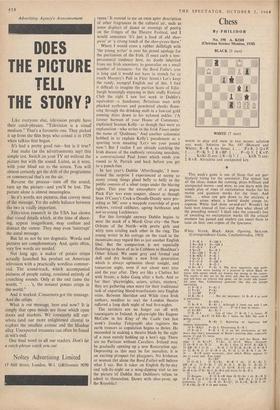Chess
By PHILIDOR No. 198 A. KISH (Christian Science Monitor, 1935)
BLACK (9 men) WHITE (7 men) WHITE to play and mate in two moves; solution ,text week. Solution to No. 197 (Howard and White): R—B 4, no threat. .1 . . . P x R; 2 QxP. 1 . . . P—K 5; 2 R X BP. I . . . P—Q 5; 2 R X P. ( . . . Ktt Kt 2) any; 2. R—Q 7. 1 . Kt(R 7) any; 2 B x R. Attractive and unexpected key.
This week's game is one of those that are par- ticularly trying for the annotator. The winner has all the ideas, makes the running, plays brilliant and unexpected 'moves—and wins; so one starts with the simple plan of rows of exclamation marks for his moves and question marks for the loser. And then . . . when one gets down to the analysis, a position arises where a horrid doubt creeps in; suppose White had done so-and-so? Woudn't he have won instead of lost—and then what about all the preceding moves? I shall take the coward's line of awarding no exclamation marks till the critical moment has passed and readers can insert them to taste on their own copies of the Spectator.
White, VLEEK. Black, ARCS. Opening, SICILIAN. (Correspondence Game, Czechoslovakia, 1963) P—R. 4 P—QB 4
2 Kt—KB 3 Kt—QB 3 3 P-0 4 PXP 4 KtxP Kt—B 3 5 Kt—QB 3 P—Q 3 6 B—KKt 5 P—K 3 7 Q—Q 2 13-1( 2 8 0 0 0 P—QR 3 9 P—B 4 B—Q 2 10 Kt—B 3 P—Kt 4. The most aggres,iye and prob- ably the best move leading to a position in which Black re- mains with pawns which are broken but strong in the centre. The results of this are on the debit side that he cannot castle and will have an inferior end game, on the credit side power- ful open files. Unbalanced positions like this are always interesting.
II P—K 5 P—Kt 5 12 P X'Kt PxKt 13 QXBP PXP
14 K—Kt 1 . . . Not yet necessary; 14 B--It 4 at once
is preferable.
14 . . . R—KKt l5 B—R 4 R—Kt I. Although it turns out well I tun not sure that this is sound. 15 . . . P—Q 4 may be better.
16 Bx1tP Kt—Kt 5 17 B—B 1 . . . loss of time: 17 B—Q 1 is better. If then 17 . . . RXP; 18 KR—Kt l seizes the KKt file with a strong attack. • 17 . . . R—Kt 5. Beginning an ingenious but dubious manceuvre.
18 P—KKt3 P—Q 4. Threatening R—B 1.
19 B—Q 3 P—K 4. It is on the correctness of this move that one's assessment of Black's previous play, especially moves 15 and 17, turns. 20 PXP? • . . After this all is well for Black. But what if 20 Kt XPI, PxKt: 21 QxP. White threatens 22 Q—R 8 ch. If 21 . . . R—Kt l then 22 BXP, R—KB 23 KR—K 1 or 21 . . B—K 3; 22 B x B. K 23 P—B 5 or 22 B—R 3; 23 Q—P. 8 ch, K—Q 2; 24 B—B 5 ch. So 21 . . . R x B seems necessary, after which White appears to me to stand well. You judge.
20 . . . KtxRP! 21 Q—K 1 21 K XKt, R—R 5 ch: 22 K—Kr 1, QR—R I; 23 P—Kt 3 (23 K—B I, B—Kt 5). I3—Kt 5; 24 Q—Kt 2, R—R 8 ch; 25 QxR, RxQ ch; 26 K xR. Q—R 4 ch; 27 K—Kt I. B—B 6 and mate, by Q—R 8.
21 . . . RXP ch! 22 Resigns. If 22 K xR then 24 Q—Kt 3 ch, K-11 1;
25 R—R 5 or if .22 K—I1 I then 22 .. KR—Kt 5; 23 Q X (otherwise. 23 . . Q—R 4), BXQl; .24 K X R, B—B 6 eh; 25 K x Kt, Q—R 4 ch and mates.














































 Previous page
Previous page